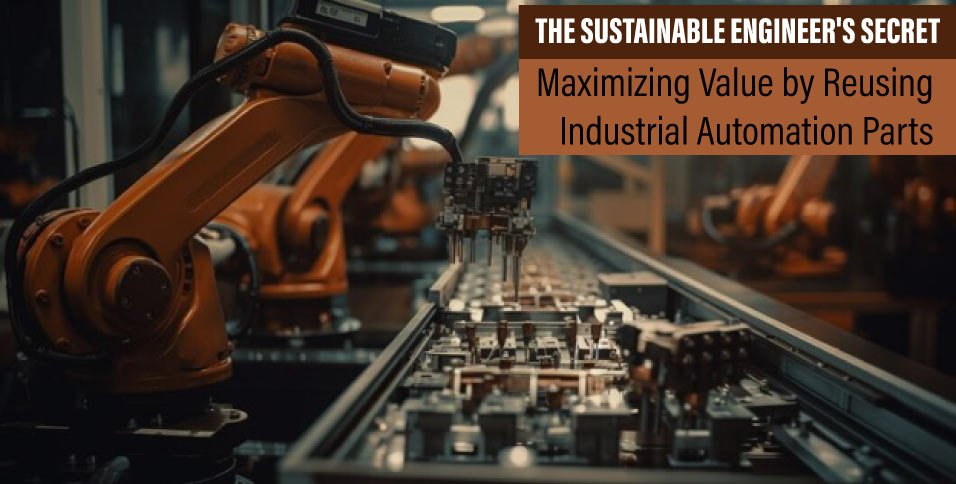In today’s ever-evolving world, the concept of sustainability has transcended mere buzzword status and is now a fundamental pillar of modern engineering. As engineers, we find ourselves at a pivotal juncture, tasked with devising innovative strategies to minimize our environmental footprint while simultaneously maximizing economic returns. Among the myriad strategies available, one particularly impactful yet often underestimated approach is the practice of reusing industrial automation parts. This practice significantly reduces waste and adds substantial value to engineering projects, making it a closely guarded secret of sustainable engineers worldwide.
In today’s ever-evolving world, the concept of sustainability has transcended mere buzzword status and is now a fundamental pillar of modern engineering. As engineers, we find ourselves at a pivotal juncture, tasked with devising innovative strategies to minimize our environmental footprint while simultaneously maximizing economic returns. Among the myriad strategies available, one particularly impactful yet often underestimated approach is the practice of reusing industrial automation parts. Not only does this practice significantly reduce waste, but it also adds substantial value to engineering projects, making it a closely guarded secret of sustainable engineers worldwide.
The Environmental Impact of Industrial Automation
Industrial automation has revolutionized a multitude of industries, ushering in unprecedented levels of efficiency and productivity. However, this convenience has not come without a price. The manufacturing and subsequent disposal of automation components contribute significantly to our planet’s carbon footprint. In this era of heightened environmental awareness, sustainable engineering calls for a resolute response to these challenges.
Enter the concept of reusing industrial automation parts—a sustainable approach that effectively addresses both environmental concerns and economic interests. By extending the lifecycle of these components, we not only reduce the need for new production and lower energy consumption. Consequently, electronic waste generation is curtailed, and the overall environmental impact is diminished. In essence, reusing automation parts is a testament to engineering’s commitment to a greener planet.
The Economic Value of Reusing Automation Parts
While the environmental benefits are apparent, the economic advantages of reusing industrial automation parts are equally compelling. Imagine the potential for cost savings when we refurbish and reuse components instead of purchasing entirely new ones. Companies that have embraced this sustainable approach have witnessed substantial reductions in operational costs, ultimately contributing to improved profitability.
In the real world, these economic gains are more than just theoretical possibilities—they are concrete achievements celebrated by organizations across various industries. Embracing sustainability isn’t just a matter of corporate responsibility; it’s also a strategic move that enhances brand image and competitive positioning.
Challenges and Considerations
Admittedly, reusing industrial automation parts is not without its challenges. Identifying suitable components, ensuring compatibility with existing systems, and addressing quality concerns can appear daunting. However, these challenges are not insurmountable hurdles but rather obstacles that can be overcome with the right approach and adherence to established guidelines.
To successfully integrate reuse practices, it’s crucial to establish clear processes and robust quality control measures. Employee training and awareness programs also play a pivotal role in mitigating potential pitfalls associated with reuse initiatives.
Environmental Benefits
Reusing automation parts contributes significantly to environmental preservation. By reducing the demand for new production, we inherently reduce greenhouse gas emissions and electronic waste, thereby playing our part in creating a cleaner and more sustainable planet.
Economic Benefits
The economic benefits of reusing automation parts extend far beyond the immediate cost savings. Embracing sustainability enhances brand reputation and fosters customer loyalty, translating into long-term economic advantages.
Technological Advances
Advancements in automation technology have further facilitated the practice of reusing components. Modular designs and standardized interfaces have made it increasingly seamless to integrate reused parts into existing systems, boosting the overall feasibility of reuse strategies.
Regulatory Compliance
Ensuring that reused components adhere to industry regulations and safety standards is paramount. Compliance not only safeguards operations but also bolsters the reputation of organizations as responsible stewards in their respective sectors.
Future Trends
The future of sustainable engineering in the realm of industrial automation holds immense promise. As technology continues to evolve, we can anticipate even more innovative ways to maximize value while minimizing our environmental footprint. Engineers and organizations that embrace these emerging trends will be well-positioned for a future where sustainability is at the forefront of engineering practices.
In conclusion, the sustainable engineer’s secret to maximizing value lies in the strategic and deliberate reuse of industrial automation parts. By simultaneously addressing environmental concerns and economic interests, this practice offers a compelling win-win solution. It is incumbent upon us, as engineers and stewards of the planet, to embrace sustainability, reduce waste, and unlock the immense value that reusing automation parts brings to our projects and industries.
For those eager to embark on this sustainable journey and explore a treasure trove of surplus automation parts, we invite you to visit Device Surplus. Here, you can find a wide array of high-quality components that not only enhance your engineering projects but also contribute to a greener and more sustainable future.
Also Read: Automation Testing Market Expects Over USD 94 Billion By 2035















